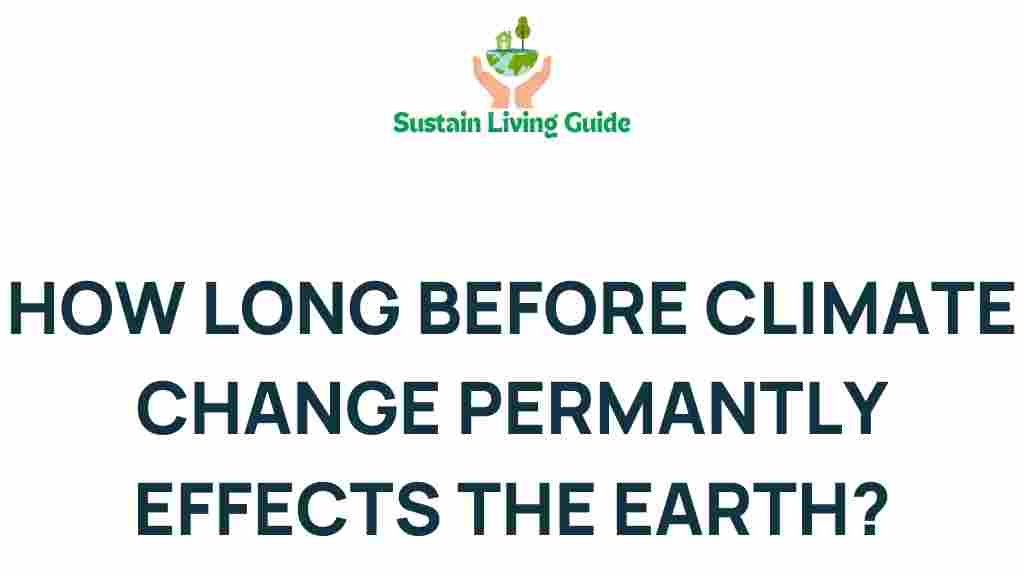The Countdown: How Long Until Climate Change Irreversibly Impacts Earth?
Climate change is one of the most pressing issues facing humanity today. It affects ecosystems, weather patterns, sea levels, and even human health. As the world continues to grapple with this complex phenomenon, a critical question arises: how long do we have until climate change irreversibly impacts the Earth? Understanding this timeline is crucial for policymakers, businesses, and individuals who want to mitigate the effects of climate change.
Understanding Climate Change
Before delving into the countdown, it’s essential to grasp what climate change entails. At its core, climate change refers to significant shifts in temperature, precipitation, and other atmospheric conditions over extended periods. These changes can be natural, but the current rapid shift is primarily due to human activities, such as:
- Burning fossil fuels
- Deforestation
- Industrial processes
- Agricultural practices
These activities release greenhouse gases (GHGs) like carbon dioxide (CO2) and methane (CH4) into the atmosphere, leading to global warming and a myriad of environmental consequences.
The Timeline of Irreversible Impacts
Scientists warn that we may have only a short window to act before the effects of climate change become irreversible. Here’s a detailed breakdown:
1. 1.5°C Threshold
The Paris Agreement aims to limit global warming to 1.5°C above pre-industrial levels. Exceeding this limit could unleash catastrophic consequences, including:
- Increased frequency and intensity of extreme weather events
- Loss of biodiversity and extinction of species
- Severe impacts on agricultural productivity
Current projections suggest we could reach this threshold as early as 2030 if significant measures are not taken.
2. 2°C Threshold
Going beyond 2°C of warming could lead to even more severe consequences, such as:
- Melting of polar ice caps and glaciers, leading to rising sea levels
- Ocean acidification, threatening marine life
- Increased human displacement due to climate-related disasters
We are on track to reach this level of warming by 2040 if current trends continue.
3. Long-term Consequences
Once we pass these thresholds, the impacts could become self-reinforcing and irreversible. Some potential long-term consequences include:
- Feedback loops that exacerbate warming (e.g., thawing permafrost releasing methane)
- Collapse of ecosystems and loss of biodiversity
- Permanent changes in weather patterns, leading to chronic droughts or floods
The consensus among scientists is that many of these effects could become irreversible by the end of the century unless significant changes are made.
What Can Be Done? A Step-by-Step Approach
While the timeline seems daunting, there are steps we can take collectively to mitigate the impacts of climate change. Here’s a structured approach:
1. Transition to Renewable Energy
Shifting from fossil fuels to renewable energy sources is crucial. Options include:
Investing in these technologies can significantly reduce greenhouse gas emissions.
2. Enhance Energy Efficiency
Improving energy efficiency in homes, industries, and transportation can also help. This can be achieved through:
- Upgrading appliances to energy-efficient models
- Implementing better insulation in buildings
- Encouraging public transport and electric vehicles
3. Reforestation and Conservation
Forests play a critical role in absorbing CO2. To combat climate change, we should:
- Plant trees in deforested areas
- Protect existing forests from logging and degradation
- Support sustainable land use practices
4. Advocate for Policy Change
Active participation in climate advocacy can lead to significant policy changes. This includes:
- Supporting legislation aimed at reducing emissions
- Encouraging corporations to adopt sustainable practices
- Voting for leaders who prioritize climate action
5. Educate and Raise Awareness
Education plays a vital role in addressing climate change. Individuals can:
- Share knowledge about climate issues within their communities
- Engage in discussions and workshops
- Utilize social media to spread awareness
For more insights on how to combat climate change, check out this resource.
Troubleshooting Common Climate Change Misconceptions
When discussing climate change, several misconceptions can arise. Here are some common issues and how to address them:
1. “Climate Change is Just a Natural Cycle”
While the Earth has experienced natural fluctuations in climate, the current rate of change is unprecedented and primarily driven by human activities. Scientific evidence overwhelmingly supports this conclusion.
2. “There’s Nothing I Can Do”
Individual actions do matter. Small changes, such as reducing waste, conserving water, and using public transportation, can collectively lead to significant impacts.
3. “Climate Change is Too Expensive to Address”
Investing in climate solutions can yield substantial economic benefits. Transitioning to a green economy is projected to create millions of jobs and generate economic growth.
Conclusion: The Urgency of Action
As we approach critical thresholds for climate change, it is imperative that we act swiftly and decisively. The countdown to irreversible impacts on Earth is ticking, and the choices we make today will determine our planet’s future. By transitioning to renewable energy, enhancing energy efficiency, promoting reforestation, advocating for policy changes, and educating ourselves and others, we can turn the tide against climate change.
We have the power to shape the future, but time is of the essence. Let’s work together to ensure a sustainable planet for generations to come. For further reading on climate change initiatives, visit this site.
This article is in the category Eco-friendly and created by SustainLivingGuide Team
